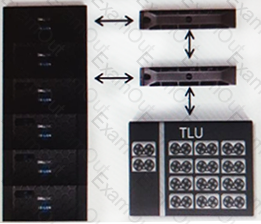SyncIQ policies are being configured between two Dell EMC Isilon clusters at a company’s location. In addition, the company wants the ability to perform a failover at an Access zone level. Which actions should be performed to meet the requirement?
An IT team is preparing to replicate a dataset from their existing primary Dell EMC Isilon cluster to a secondary cluster. Both clusters are licensed for SmartLock Enterprise and SyncIQ is used for replication. The source directory is a SmartLock directory and the target directory must be a SmartLock directory.
When consulting with the IT team, what is a key consideration before running the replication policy?
A Dell EMC Isilon administrator wants to know which workloads benefit from using L3 Cache. Which type of workloads will address the administrator’s inquiry?
A company is planning to replicate a dataset to a newly implemented Dell EMC Isilon cluster. SyncIQ will be used from the source cluster to the target cluster. The company’s systems administrator wants to know how long the initial synchronization will take without seeding. The administrator provides the following information:
Link speed between clusters is 1 Gb/s
Link speed efficiency is 85%
SyncIQ domain size is 125TB
If no SyncIQ performance rules are set, what is the estimated number of days?
SPECIAL INSTRUCTIONS
The remaining Part1 questions are associated with four case studies that describe various environments or settings. Each case study appears on its own display screen. Questions for each case study will appear on separate display screens.
When displaying a question, you can easily review the related case study by clicking on the “Review Case Study” icon shown below:

Case Study 5 – Refer to the Exhibit.
Backing up data from a Dell EMC Isilon cluster exceeds the company’s backup window. Because the company has a large amount of data with a continuous high growth rate, they want to change their backup strategy. The Gen 6 Isilon cluster consists of 24 nodes. Their current backup strategy is an NDMP three-way backup performing weekly full backups to tape and incremental backups each night. The strategy uses Dell EMC NetWorker. The DMA uses Include paths to specify what data to backup. All data on the cluster must remain accessible.
The company’s IT team is now looking for a new data protection strategy. The company wants to:
Minimize the backup window
Increase the speed of data recovery
Reduce the network traffic
Reduce the overall growth of the backup datasets
The IT Team indicates that their currently backup hardware will be used in any solution. Which solution meets their requirements?
Case Study 4
A company is experiencing a noticeable decrease in performance when accessing data on their Dell EMC Isilon cluster. The cluster hosts Microsoft Windows home directories and general purpose file shares. In addition, a file pool policy moves data that has not been modified in six months to an achieve tier. The administrator wants your assistance in understanding the reason for the slow data access. The number of users accessing the cluster has not changed. The administrator has shared the following baseline metrics. The outputs were captured from a performance- acceptable time frame.
Trace route shows:
-3 hops between clients and the cluster
-Average latency is 3 ms
Iperf shows:
-940 Mb/s average bandwidth
-005 ms average jitter
Netstat on the local network shows:
-05% average re-transmission rate
Hostcache list:
-20 ms average roundtrip time across all clients
The administrator shows you the following iperf output:
-890 Mb/s average bandwidth
-98.8 ms average jitter
Based on the output, what information should be provided to the administrator?
A company has an environment with multiple AD forests in a one-way trust relationship. The AD provider on the cluster is configured with SFU. The trusted domains are failing to supply UIDs and GIDs to the Dell EMC Isilon cluster. As a result, users from the trusted domain are receiving an “access denied” error message.
What is a possible reason for the denial?

